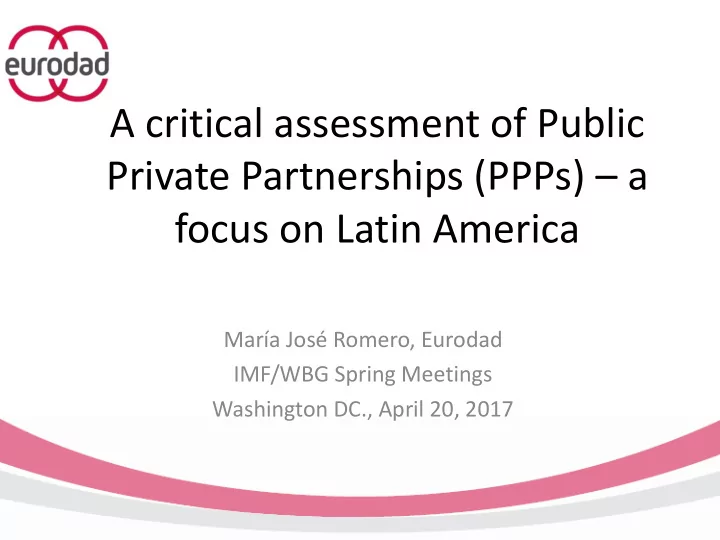

A critical assessment of Public Private Partnerships (PPPs) – a focus on Latin America María José Romero, Eurodad IMF/WBG Spring Meetings Washington DC., April 20, 2017
Presentation: main points 1. What are PPPs? 2. Why use PPPs? 3. How important are PPPs (globally and in LAC? - Specific features of PPPs in LAC - Are countries getting ready? 4. PPP: Problems, Problems, Problems 5. Concluding remarks
1. What are PPPs (I)? 1. a medium / long-term contractual arrangement between the state and a private company; 2. private sector supplies ‘public’ assets and services (those traditionally provided by government, such as hospitals, schools, prisons, roads, sanitation etc) 3. risk sharing between the public and private sector.
1. What are PPPs (II)? 1. ‘User pays’ – close to a genuine private investment 2. ‘Government pays’ – another form of government borrowing
2. Why use PPPs? Advantages for governments: Hides government debt. Efficiency + ideology: “ the private sector is more efficient” Advantages for the private sector: New business sector (government pays) Reduced risk (guaranteed income + government and multilateral guarantees.)
3. How important are PPPs? (I) Figure 1: Total investment in PPPs and number of projects in the developing world, 2003 – 2015 (billion US$ in real terms) Source: Eurodad’s own calculations based on Private Participation in Infrastructure Projects Database (*adjusted by US Consumer Price Index)
3. How important are PPPs? (II) Total investment commitments in PPPs per region (in million dollars) 80000 70000 60000 50000 40000 30000 20000 10000 0 2003 2004 2005 2006 2007 2008 2009 2010 2011 2012 2013 2014 2015 Latin America and Caribbean South Asia East Asia and Pacific Europe and Central Asia Middle East and North Africa Sub Saharan Africa
3. How important are PPPs (III)? • Special features of PPPs in LAC : Over 94% of total PPP investment in LAC concentrated in only 5 countries: 1. Brazil (65%) 2. Mexico (11%) 3. Colombia (7%) 4. Peru (6.4%) 5. Chile (5.3%) - However, relative to the size of the economy, Honduras led the region with PPP investments of 2% of GDP, followed by Peru (1.6%), Nicaragua (1.5%), and Jamaica (1.3%).
3. How important are PPPs (IV)? • Special features of PPPs in LAC : - PPP investment in LAC is highly concentrated in energy (over 48% of total PPP investment) and transport (over 46%, mostly road investment). - Public finance is key! about a third of PPP financing comes from public institutions, and about half of all PPP deals in LAC received some form of government support (direct or indirect), which creates contingent liabilities on public coffers.
3. How important are PPPs (V)? • Are countries getting ready for PPPs? - Infrascope (2014) does not yet rank any country in LAC as “mature.” The top 5 are ranked as “developed” PPP environments, nine as “emerging,” and five as “nascent.” - MDBs focus on the enabling environment for PPPs: changes in the regulatory framework. Is this source of relief or cause for concern? Most guidelines are problematic and DO NOT warn countries explicitly and clearly against the fiscal risks associated with PPPs.
4. P roblems P roblems P roblems Usually the most expensive method of financing Up to twice cost of government borrowing. User fees can exclude poor from access to services. Very complex to negotiate - often renegotiated 55% PPPs renegotiated, increase in tariffs in 62% of cases. In LAC: 70% infrastructure PPPs renegotiated, and 92% water-related projects. Low transparency and limited public scrutiny PPP contracts are subject to commercial confidentiality issues.
5. Concluding remarks Driving forces behind PPP push not developmental : Hide government debts off balance sheet Ideological push by international actors (and behind them commercial lobby) A cause of concern: changes in the regulatory framework Main demand? Select the best financing mechanism, including examining the public borrowing option, on the basis of a comprehensive and transparent analysis of the true costs and benefits over the lifetime of the project, and the risk comparison of each option.
Recommend
More recommend